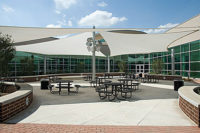The Houston Methodist Hospital in Houston, TX, comprises over 5 million sq ft and includes a central utility plant, steam production, and CHP capable of producing 14,800 tons of chilled water capacity.
HMH Facility Management Services is responsible for maintaining all aspects of the mechanical systems engineering. They are also charged with implementing energy efficiency opportunities that increase performance and reduce utility costs.
Bruce Flaniken, P.E., manager of design and construction engineering; and Eric Herrera, manager of central plant operations; said this is no easy task.
“We are constantly under pressure to not only maintain operations, but to do so with equipment that sometimes underperforms,” said Flaniken. “This can make our job more that of a magician than an engineer.”
One problem that can plague large chilled-water and hot-water central plants is low return water delta-T (∆T). Low ∆T is character-ized by secondary system water that returns to a chiller or boiler (from AHU coils) at temperatures below design. An example would be a variable flow system returning 52°F water to a chiller designed to operate at 54°F return and 42°F supply (12°F ∆T). If operated under these conditions with full capacity required, an approximate 17% decrease in chilled water production would be experienced because of low ∆T. If more cooling capacity were required to meet the building load, additional chillers and pumps would need to be started, versus using the already operational chiller and pumps to their fullest ability, wasting energy, and possibly reducing overall plant capacity.
“Our campus struggles with low secondary chilled water ∆T, which limits the capabilities of our CUP and requires additional chillers and pumps to run unnecessarily, increasing energy consumption,” said Herrera.
He explains that Low ∆T carries penalties resulting from reduced thermodynamic performance of chillers and boilers, subpar terminal unit (coil) temperature delivery, and increased water flow, all leading to higher utility bills.
“Our ultimate goal is to maximize CUP performance by optimizing the equipment, piping, pumping, and controls already installed. We’ve made a major financial investment, having purchased the most efficient equipment possible. Now we need to tweak and fine tune things to create a functional synergy,” said Herrera.
With a goal of reducing energy consumption and associated carbon footprint by at least 10% over the next 12 months, the hospital’s FMS team is constantly searching for opportunities to increase plant performance. Flaniken considers improving chilled water ∆T to be a viable process in helping achieve this goal.
“We see ∆Ts ranging anywhere from 9°F to 14°F where the design may be as high as 20°F. Reduced return water temperatures like these yield a substantial performance and energy penalty that we consider unacceptable. We have targeted the improvement of low ∆T as a major action item moving forward,” he said.
Methodist Hospital took a big step forward when it included the installation of Danfoss pressure independent control valves (PICV) on several existing air handling units that had been found to be underperforming. James A. Law III, manager of engineering operations and maintenance at the hospital, has responsibility for the hundreds of AHUs serving the hospital campus.
“When you consider the huge impact that air delivery systems have on a hospital’s energy profile, it doesn’t take long to realize that, if you can cost-effectively improve performance, it will have a big bang for the buck,” he says.
One underperforming 100% outdoor AHU was singled out by Law.
“We couldn’t seem to get this unit to provide properly conditioned supply air regardless of how much additional chilled water we tried to flow through the coil,” he said. “Based on Houston’s high summertime humidity and our need to provide deeply dehumidified air to certain areas of the facility, this unit was designed to produce leaving air at 47°F, but unfortunately we were not getting air anywhere close to this temperature.”
So FMS staff cleaned the unit’s cooling coils and replaced the old chilled water control valve with a new Danfoss PICV. The combination of removing dirt from the coil surfaces and installing the new control valves improved chilled water ∆T across the cooling coil by 63%. The air handling unit was once again functioning properly, and with additional capacity to boot.
Law was more than pleased with the installation.
“The Danfoss pressure independent control valves allowed us to quickly field-calibrate each valve for precise chilled water flow without cumbersome test and balance,” he said. “These valves maintain the design flow rate to the cooling coil regardless of any flow/pressure fluctuation that may be occurring elsewhere in the system.”







